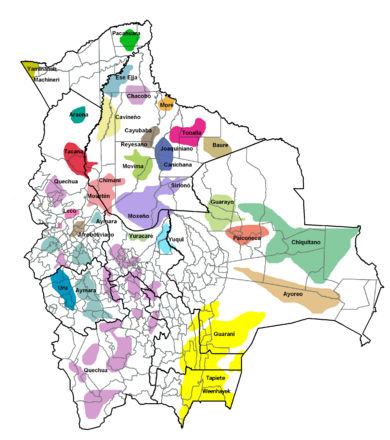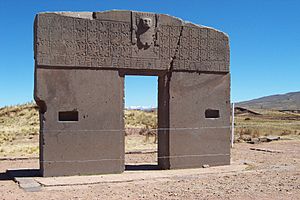Indigenous peoples in Bolivia facts for kids

|
|
| Regions with significant populations | |
|---|---|
20-62% of Bolivia's population |
|
| Languages | |
| Aymara, Guarani, Quechua, Spanish, and other Indigenous languages | |
| Religion | |
| Roman Catholicism, Evangelicalism, Irreligion, Native religions | |
| Related ethnic groups | |
| Aymarás, Guaranís, Quéchuas, Mestizos in Bolívia |
Indigenous peoples in Bolivia, also known as Native Bolivians, are people in Bolivia who have ancestors from the original groups living in the Americas. They make up a large part of Bolivia's population, between 40% and 70% of its 11.3 million people. There are 36 different Indigenous groups recognized in Bolivia. The two largest groups are the Aymara and Quechua. Bolivia's land includes the high Andes mountains, the Gran Chaco plains, and parts of the Amazon rainforest.
About 30% to 68% of the population are mestizo. This means they have a mix of European and Indigenous ancestors.
Contents
Indigenous Lands in Bolivia
Indigenous Bolivians collectively own special areas of land. These are called Native Community Lands or Tierras Comunitarias de Origen (TCOs). These lands cover a huge area, about 11 million hectares (which is about 27 million acres!).
Some important TCOs include:
- Kaa-Iya del Gran Chaco National Park and Integrated Management Natural Area
- Isiboro Sécure National Park and Indigenous Territory
- Pilón Lajas Biosphere Reserve and Communal Lands
- Yuki-Ichilo River Native Community Lands
Protecting Indigenous Rights
Bolivia has taken steps to protect the rights of its Indigenous peoples.
- In 1991, the Bolivian government signed an important international agreement called the Indigenous and Tribal Peoples Convention, 1989. This agreement helps protect Indigenous rights around the world.
- Later, in 2007, Bolivia passed Law No. 3760. This law approved the UN Declaration on the Rights of Indigenous Peoples.
- In 1993, a new law called the Law of Constitutional Reform officially recognized Indigenous Rights in Bolivia's constitution.
Social Protests and Political Action
Early Movements for Change
For many years, Indigenous people in Bolivia faced a lot of unfair treatment. They did not have much say in politics. In the mid-20th century, things started to change.
- The 1952 war gave all Bolivians, including Indigenous peoples, citizenship. However, Indigenous communities still had little political power.
- In the 1960s and 1970s, social movements began to speak up for Indigenous concerns. One important movement was called Katarismo. This group, mainly made up of Aymara communities, wanted to create a strong Indigenous political identity. They tried to get involved in mainstream politics.
- Even though the Katarista movement did not create a national political party, it influenced many farmer unions.
Growing Protests in the 1990s and 2000s
The 1990s and 2000s saw a big increase in political action by Indigenous communities.
- In 1993, President Sánchez de Lozada passed reforms to recognize Indigenous rights. But many felt these reforms were not enough. The government continued to make rules that harmed the environment and Indigenous communities.
- In 1994, the Law of Popular Participation gave more power to local governments.
- In 1996, the Electoral Law further expanded Indigenous political rights. It helped more Indigenous representatives get elected to the national congress.
Protesting Environmental Issues
Environmental issues became very important. Many Indigenous communities protested against the government's plans to privatize (sell to private companies) and destroy natural resources.
- Coca Leaf Protests: Growing coca leaf is important for Bolivia's economy and culture, especially for farmers and Indigenous peoples. The government tried to stop coca production, which led to big protests.
* Evo Morales became a main leader of the coca leaf movement. He spoke out against the government's efforts. * Protests in the Chapare region in 2000 became violent. Protesters blocked roads and stopped traffic. * Under Evo Morales' leadership, the coca farmers formed alliances with other groups. They eventually created a political party called the Movement Towards Socialism (MAS).
The Water War
In 2000, the "Water War" brought national attention to the protests.
- In the city of Cochabamba, a private company called Bechtel took over the water system. They greatly increased water prices.
- When people could not afford water, they protested. City workers, rural farmers, and students joined together.
- The protests became violent, and the government declared a state of emergency.
- The protests were successful! The government reversed the privatization, and water prices went back down.
The Gas Wars
In 2003, as Bolivia's economy relied more on natural resources, Indigenous communities protested again in the "Gas Wars."
- This conflict followed the Water Wars. Coca farmers, unions, and citizens protested selling Bolivia's gas reserves to the United States through Chile.
- Indigenous peoples, miners, teachers, and ordinary citizens blocked roads and disrupted traffic.
- These protests for social and economic changes have been a common way for Indigenous people to get involved in politics. They have often led to successful results and helped create a platform for Indigenous Rights.
The 2011 Indigenous March
In 2011, Indigenous activists in Bolivia started a long protest march. They walked from the Amazon plains to the capital city, La Paz.
- They were protesting a government plan to build a 306 km (190 mile) highway. This highway would go through a national park that was also Indigenous territory.
- Indigenous groups like the TIPNIS subcentral, the Confederation of Indigenous Peoples of Bolivia (CIDOB), and CONAMAQ organized the march.
- On September 25, 2011, national police violently stopped the marchers. This event became known as the "Chaparina Massacre."
Evo Morales and the Plurinational State
A major success for Bolivia's Indigenous community was the election of Evo Morales. He was a former leader of the coca farmers and became Bolivia's first Indigenous President.
- President Morales worked to create a plurinational state. This means a state that recognizes and respects many different nations or peoples within its borders. He wanted to expand the collective rights of Indigenous communities.
- The 2009 constitution recognized the many different communities in Bolivia. It gave Indigenous peoples the right to govern themselves and control their ancestral lands.
- In 2010, the Framework Law of Autonomies and Decentralization explained how Indigenous communities could gain autonomy.
- Through these efforts, Bolivia became the first plurinational state in South America.
- However, some Indigenous communities say that the process to gain autonomy is still too slow and difficult.
Important Achievements
In 2015, Bolivians made history again. They elected the first Indigenous President of the Supreme Court of Justice, Justice Pastor Cristina Mamani.
- Justice Mamani is a lawyer from the Aymara community in the Bolivian highlands.
- She won the election with the most votes.
- The Supreme Court of Justice has nine members and nine substitute justices. Each represents one of Bolivia's nine departments.
- These justices are elected by the people in non-political elections and serve for six years.
Indigenous Groups in Bolivia
Ancient Cultures
- Tiwanaku, 300–1000 AD
- Mollo culture, 1000–1500 AD
- Lupaca
- Charca people
- Payaguá people
- Uru-Murato
Modern Groups
- Araona
- Aymara, Andes
- Ayoreo, Gran Chaco
- Baure, Beni Department
- Borôro, Santa Cruz Department
- Callawalla, Andes
- Canichana, lowlands
- Cavineños, northern Bolivia
- Cayubaba, Beni Department
- Chácobo, northwest Beni Department
- Chané, Santa Cruz Department
- Chipaya, Oruro Department
- Chiquitano, Santa Cruz Department
- Ese Ejja, northwest Bolivia
- Guaraní
- Guarayu
- Guató
- Ignaciano, Beni
- Itene, Beni
- Itonama
- Kolla
- Jorá
- Leco, east Lake Titicaca
- Machinere, Pando Department
- Movima, Beni
- Nivaclé, Gran Chaco
- Pacahuara, Beni
- Paunaka, Ñuflo de Suarez
- Pauserna, Beni
- Quechua, Bolivia
- Reyesano, Beni
- Saraveca, Santa Cruz
- Shinabo
- Sirionó, Beni and Santa Cruz
- Tacana, La Paz Department
- Tapieté, Tarija Department
- Toba, Tarija Department
- Toromona, La Paz Department
- Trinitario, Beni
- Tsimané, Beni
- Uru, Oruro Department
- Wichí, Tarija Department
- Yaminawá, Pando Department
- Yuqui
- Yuracare, Beni and Cochabamba Departments
See Also
 In Spanish: Grupos étnicos de Bolivia para niños
In Spanish: Grupos étnicos de Bolivia para niños
- Demographics of Bolivia
- Mestizos in Bolivia
- White Bolivians
- Confederation of Indigenous Peoples of Bolivia
- Andean music
- Andean textiles
- Ekeko, Andean god of abundance
- El Fuerte de Samaipata, archeological site
- Guarani mythology
- History of Bolivian nationality
- Kallawaya, traditional healers
- Yanantin, complementary dualism in Andean philosophy



